Erica Jurus's Blog, page 4
March 4, 2025
The Earth’s Entrances to the Underworld
There’s a plain just east of Naples, Italy that smolders away. I’ve been to a place like that before, on the island of St. Lucia, a large, collapsed volcanic crater called Sulphur Springs. It’s been dormant since the 1700s, but it doesn’t seem that way when you’re watching steam boil out of vents and mud bubble and ooze.
The Italian plain is called Campi Flegrei, and it’s a not-so-dormant caldera nine miles in diameter. It’s been fussing around for several recent decades, and researchers are finding evidence that the underlying volcano is more active than they thought. If they’re correct, the roughly 400,000 residents in the area may find out in modern times why the ancients thought it was an entrance to Hell.
Heaven has always been thought to lie somewhere far above us, in the…heavens, but the Netherworld seems to be under our feet, and perhaps not so far down as we might wish for comfort. There are numerous locations on our planet believed to give direct access to Hell, perhaps because that’s considered an easier route? 
In my novels, there are living people who’ve found a way to get to the Underworld, although their souls are so stained that there’s no going back – or is there? And there are plenty of denizens of the dark plane who’d be interested in creating some mayhem in the world of the living. The grass is always greener (or blacker)…
Out of Time, the third and final novel of the Chaos Roads trilogy, reveals how that all works, should any of my readers find it of particular interest. (Warning: do not attempt the passageways yourself under pain of eternal damnation.)
So what did ancient religions believe? They also felt that some places on the planet were ‘evil’, i.e. the portals to Hell. Let’s look at others besides the Phlegrean Fields (PSA warning to be kept in mind):
Israel: Valley of Hinnom 2007 By Deror avi – Own work, CC BY-SA 3.0, https://commons.wikimedia.org/w/index.php?curid=2944917
Valley of Hinnom 2007 By Deror avi – Own work, CC BY-SA 3.0, https://commons.wikimedia.org/w/index.php?curid=2944917Gehenna, a deep gorge located just outside the walls of old Jerusalem. Its name is a shortening of “Valley of Hinnom”, aka “Ge-Hinnom”. According to the Bible, ancient Israelites sacrificed their own children to the god Baal there. By the era of Jesus, it had understandably gained a reputation for evil. Some old accounts say that the valley was used for two things: dumping in corpses of those excluded from the kingdom of Heaven, as well as garbage where fires burned constantly. That may have inspired the concept of sinners roasting in eternal fire, which is the image we all have in our heads today.
2. Iceland: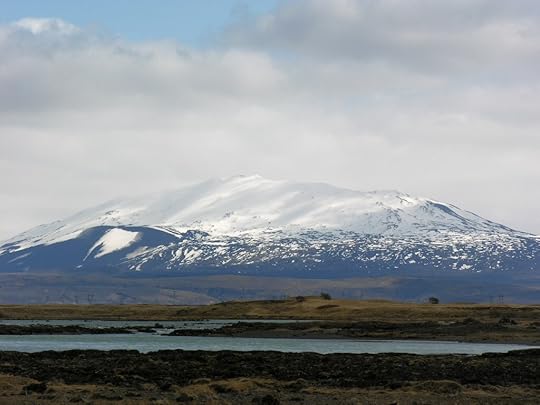 Hekla Volcano By Hansueli Krapf – Own work: Hansueli Krapf (User Simisa (talk · contribs)), CC BY-SA 3.0, https://commons.wikimedia.org/w/index.php?curid=9372621
Hekla Volcano By Hansueli Krapf – Own work: Hansueli Krapf (User Simisa (talk · contribs)), CC BY-SA 3.0, https://commons.wikimedia.org/w/index.php?curid=9372621Hekla Volcano. “The renowned fiery cauldron of Sicily, which men call Hell’s chimney … that cauldron is affirmed to be like a small furnace compared to this enormous inferno.” Herbert de Clairvaux, a Cistercian monk in 1180, became pretty freaked out about Helka after its massive eruption in 1104, which covered over half of Iceland in ash and rock. It’s believed to have been equivalent in force the eruption of Mount St. Helen. Hekla had been dormant for some time, so this surprise eruption was soon attributed to diabolic forces.
In 1120, a monk named Benedeit claimed the mountain was the prison of the betrayer Judas, and gave access to the lowest circles of Hell. A few decades later De Clairvaux compared it to Mount Etna in Italy (the ‘small furnace’). A medieval author got a bit fanciful by stating that large birds entering the volcano’s top were the souls of the damned flying in. Hekla continues to display its prowess, spewing voluminous amounts of lava and debris for hundreds of years. In 2000, it produced a fissure 4.3 miles long – now, if that isn’t an invitation to Hell, what is?
3. Turkey: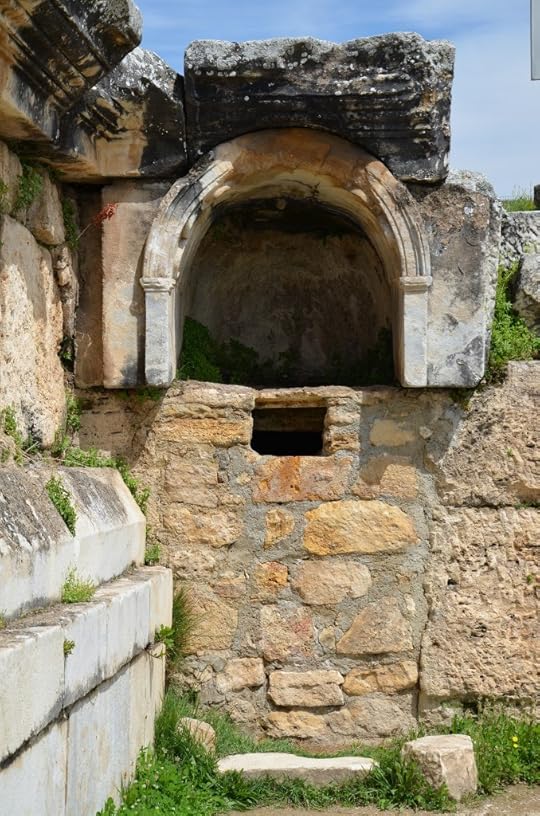 The Ploutonion By Carole Raddato from FRANKFURT, Germany – The Plutonium (Pluto’s Gate), a sacred cave believed to be an entrance to the underworld and the oldest local sanctuary, Hierapolis, Phrygia, Turkey, CC BY-SA 2.0, https://commons.wikimedia.org/w/index.php?curid=55185949
The Ploutonion By Carole Raddato from FRANKFURT, Germany – The Plutonium (Pluto’s Gate), a sacred cave believed to be an entrance to the underworld and the oldest local sanctuary, Hierapolis, Phrygia, Turkey, CC BY-SA 2.0, https://commons.wikimedia.org/w/index.php?curid=55185949Hierapolis – The Ploutonion. Hierapolis was an ancient Roman city built during the reign of emperor Tiberius in southwestern Anatolia, famous for its hot springs, which have been used as a spa since at least the 2nd century BCE. But just where was all that lovely heat coming from?
On one wall of the large open arena, there was a cave-like grotto. Priests of the underworld would carry sacrificial animals down through the door, known as the Ploutonion, and the spectators would watch in horror as the animals died on the spot. The philosopher Strabo stated that “The] space is filled with a cloudy and dark vapour, so dense that the bottom can scarcely be discerned…Even bulls, when brought within it, fall down and are taken out dead.” Modern scientists have found that the Ploutonion sits on top of the fault line of an active volcano, which would send out thick clouds of Carbon Dioxide. The ancient Romans believed it was the breath of Kerberos (Cerberus), the three-headed dog that guards Hell. Sounds pretty conclusive to me.
4. Belize: ‘Cave of the Stone Sepulcher’ By Peter Andersen – Own work, CC BY-SA 3.0, https://commons.wikimedia.org/w/index.php?curid=295574
‘Cave of the Stone Sepulcher’ By Peter Andersen – Own work, CC BY-SA 3.0, https://commons.wikimedia.org/w/index.php?curid=295574There’s a cave in the jungles of Belize called Actun Tunichil Muknal – ‘Cave of the Stone Sepulcher’. It contains three miles of tunnels that contain the remains of numerous human sacrifices. It remained undiscovered and undisturbed for more than 1,000 years after the Mayan Empire collapsed, and when it was stumbled across, archaeologists were shocked. The most famous of the sacrificial victims is called ‘The Crystal Maiden’ – it’s so old that the bones have crystallised. Researchers believe that the cave was revered as an entrance to the Mayan Underworld, the dreaded Xibalba, domain of the gods of death.
There are more in Japan, China, Ireland, New Orleans (of course). But if you’re looking for a dark adventure, you needn’t go that far – go to Pennsylvania. In Hellam Township, the woods conceal a big surprise, and it’s not a Teddy Bear Picnic. The story goes that an ‘eccentric’ doctor who once lived in town designed a series of strange gates on his property. Anyone following the path and passing through the portals in order would find themselves transported straight to Hell. Apparently only the first gate is visible by daylight. What does that mean for the other gates, then? Number One is located just off Hellam’s Trout Run Road, if you’re feeling brave.
As the saying goes, the Road to Hell is paved with good intentions – yikes! Should you desire to check any of these places out for yourself, take lots of holy water. Maybe read the third book of my series first (coming out June 2025, or May 31 launch at the Niagara Falls Comic Con!)
February 25, 2025
It’s a matter of opinion
The most intimidating thing about producing a piece of art, whether it’s a novel, a painting, a script, a movie or whatever, is putting it out there for people to look at. Even though that’s the end goal – to share your vision – the act of letting others see it is an enormous leap of faith.
When I finished my first novel, I could only perform about three edits before I ran out of steam. You just become too close to your material, and there’s a danger of driving yourself crazy trying to make it perfect.
So I recruited a group of what are called ‘beta’ readers to read the book and give me their feedback. I had very specific questions I wanted them to address, but mainly, I needed to know if anyone even liked the story. You have this thing in your head, you see, that you think is pretty cool, but you have no way of knowing if it will appeal to someone else. You put blood, sweat and tears into it for months, and then you cross your fingers that it will all have been worth it.
It was tough handing over my baby. I asked my reviewers to be candid, but not insulting. Then I waited not-so-patiently for my beta readers to finish a fairly lengthy novel (about 190,000 words – not a huge stretch for a fantasy-type book, which typically runs around 150K or so, but still) in a style that bucked current trends.
The net result was that all my readers loved the book – a very happy outcome. But they had really good insights for me about what wasn’t working, and sometimes very differing opinions on a few aspects. That was okay. It gave me an idea of what a variety of average readers might feel.
Things could have gone the other way. If no one liked the first book, at least I’d given the thing a shot, so no regrets regardless.
Now that the first two books of the trilogy are out, I’ve been engrossed in what grabs some people – favourite characters (Moltkin and Heltkil have been enormously popular, as has Enoch Crowe, the villain), aspects that they really cottoned onto (e.g. descriptions of the food) – and their speculation about how certain issues are going to play out in Book 3. As the author, it’s delightful that my readers have become so engaged, and I’ve had so much fun subverting their expectations and leaving people guessing.
In the television and movie world, though, a vision that flops can become a very expensive proposition. Critics can be devastating, and I frequently disagree with them.
When the movie The Mummy with Brendan Fraser came out in 1999, it got panned as a piece of fluff, but both my hubby and I loved it. It was a great romp with a lot of humour and fabulous cinematography that harkened back to the adventure movies of early Hollywood. Was it Oscar-worthy? No, but it entertained the hell out of us. Did I love every single scene? No, I had a few things to nitpick at, but overall it transported me to a time period of mystery and exotic quests, which was right up my alley.
I’ve also watched movies that the critics loved and I didn’t. Tastes are very individual, and sometimes a story, or a setting, really touches us, but not someone else.
In 1981, along came an award show called The Razzies, with prizes that no one in the film industry wants to win. But at least the Razzies poke fairly gently at what they consider the worst ventures of the year. The trophy is small and not expensively produced. It features a golden raspberry about the size of a golf ball that’s a metaphor for the somewhat tongue-in-cheek act of blowing a ‘raspberry’ at someone.
Numerous very successful actors, producers and directors have been nominated for, and received, a Razzie. For 2019, for example, Dame Helen Mirren was nominated for her acting in the movie “Winchester”. Now personally, I’ve never seen her give a bad performance, and I even rather like the movie, which was also nominated for Worst Picture. I think critic Stephen Dalton of The Hollywood Reporter ‘s assertion that “Winchester is a visual treat, its palette aglow with bronze and turquoise tints that suggest colorized Victorian postcards,” but “promises more sophisticated shocks and psychological depths than it ultimately delivers” was pretty valid, all in all.
The only movie and performances I’ve seen on this year’s slate is Madame Web, which I felt was more lacklustre and a bit confusing than terrible, although I’ve certainly heard about some of the other nominees. I suspect that sometimes the problem might have been a case ‘too many cooks spoiling the broth’, and the original vision got lost in the shuffle. And sometimes it may have just been bad judgement on a writer/producer/director’s part.
The purpose of the Razzies, as per their website, is for artists to “Own Your Bad”. Sandra Bullock received a Razzie award for Worst Actress for her performance in All About Steve, which, if the poster on IMDB.com is anything to go by, looks like a bit of a stinker. But she made the best of it with a delightfully funny acceptance speech, which you can watch on YouTube.
This year’s nominees are:
Worst Picture
BorderlandsJoker: Folie a DeuxMadame WebMegalopolisReaganWorst Actor
Jack Black in Dear SantaZachary Levi in Harold and the Purple CrayonJoaquin Phoenix in Joker: Folie a DeuxDennis Quaid in ReaganJerry Seinfeld in UnfrostedWorst Actress
Cate Blanchett in BorderlandsLady Gaga in Joker: Folie a DeuxBryce Dallas Howard in ArgylleDakota Johnson in Madame WebJennifer Lopez in AtlasWorst Supporting Actor
Jack Black (Voice Only) in BorderlandsKevin Hart in BorderlandsShia LaBeouf (in drag) in MegalopolisTahar Rahim in Madame WebJon Voight in Megalopolis, Reagan, Shadow Land & StrangersWorst Supporting Actress
Ariana DeBose in Argylle & Kraven the HunterLeslie Anne Down (as Margaret Thatcher) in ReaganEmma Roberts in Madame WebAmy Schumer in UnfrostedFKA twigs in The CrowWorst Screen Combo
Any Two Obnoxious Characters (But Especially Jack Black) / BorderlandsAny Two Unfunny “Comedic Actors” in UnfrostedThe Entire Cast of MegalopolisJoaquin Phoenix & Lady Gaga in Joker: Folie a DeuxDennis Quaid & Penelope Ann Miller (as “Ronnie and Nancy”) in ReaganWorst Director
S.J. Clarkson for Madame WebFrancis Ford Coppola for MegalopolisTodd Phillips for Joker: Folie a DeuxEli Roth for BorderlandsJerry Seinfeld for UnfrostedWorst Prequel, Remake, Rip-Off or Sequel
The CrowJoker: Folie a DeuxKraven the HunterMufasa: The Lion KingRebel Moon 2: The ScargiverWorst Screenplay
Joker: Folie a DeuxKraven the HunterMadame WebMegalopolisReaganThe awards will be presented this Saturday, March 1st. Check out the Razzie Channel for the results! And if my novels ever get made into movies, I hope they don’t win one of these awards 
February 19, 2025
Turning words into art
“I would go from one city to the next, inspired by the monks in the Middle Ages, who would carry knowledge from one monastery to the next monastery.” Hans-Ulrich Obrist, Swiss art curator, critic, and art historian; artistic director at the Serpentine Galleries, London.
What to do when your mother-in-law states that she has one more trip she’d like to go on: to England with her son and you?
It was a request that came out of the blue, while we were being transported from the airport in Los Angeles to the house of friends in Santa Monica. We’d actually asked her to come to England with us years before, but she’d always found an excuse not to go.
But she’d made this statement in front of several people, so when we took her up on it, she had no excuse to fall back on. I began planning out a trip I thought she’d enjoy, and then she said, “You know, I’ve heard that it’s really easy to go from London to Paris. Could we go to Paris for a day?”
Well, we decided to make the trip ‘a tale of two cities’: four days in London, then the Chunnel Train to Paris for another four days.
We had a blast. She was in her early 70s at that time, but we’d already travelled with my mother, so we knew how to pace things. I planned a mix of sights and activities, and one of them was just walking around each city to get to know it intimately.
We stayed in the Latin Quarter in Paris, at a very atmospheric boutique hotel situated beautifully amidst all kinds of sights, and just down the street we came across the Cluny Museum of the Middle Ages. It’s a wonderful place, filled with treasures, including illuminated manuscripts, and that’s where my fascination with them took hold. I even bought a quite large book about them in the gift shop and lugged it all the way home.
 Photos of the exterior of the Cluny Museum from our trip, by E. Jurus, Author, all rights reserved
Photos of the exterior of the Cluny Museum from our trip, by E. Jurus, Author, all rights reservedWhen I was fleshing out the heroine of my Chaos Roads trilogy, Romy Ussher, I knew that she had to be an archivist, with the same intense interest in preserving knowledge as her patron, the Egyptian god Thoth. And it was a natural fit that she’d specialize in illuminated manuscripts.
Illuminated manuscripts are gorgeous works of art, which monks began toiling over as early as the 6th century. The monks lit up the ‘Dark Ages’ with the beauty of their work, turning simple pages of text into rich collections of imagery at a time when books were scarce and incredibly valuable, taking hours and hours of hand-writing and painting by candle light.
Manuscripts are so named from two words from Latin: manus, or hand, and scriptus, or writing. Centuries before the invention of the printing press by Johannes Gutenberg, making copies of books like the Bible for churches and monasteries to use required laborious copying, letter by letter, with ink and a quill pen, in the elaborate scripts of the time period. It was painstaking work – no ‘back’ button or ‘undo’ to fix errors.
Then, designated artists would paint in small, intricate decorations, adding ornate capital letters, elaborate borders, and painted scenes called miniatures. The illustrations were meant to guide readers through the text, which was critical during medieval times when many people didn’t know how to read.
The word “illuminated” was also taken from Latin: illuminare, meaning ‘lighted up’. And it actually referred to being decorated with gold, applied in the form of gold leaf.
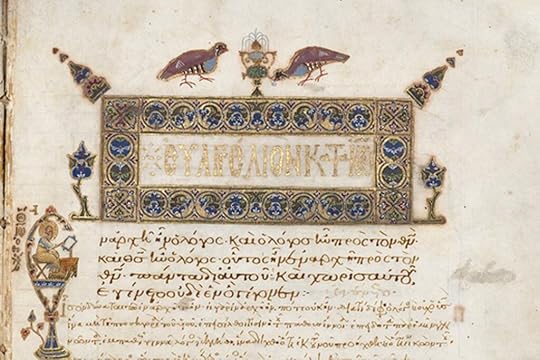 Section of an illuminated ms showing the gold leaf – Source: Byzantium Constantinople 11th century – Gospel Book with Commentaries – 1942.152 – Cleveland Museum of Art, https://commons.wikimedia.org/w/index.php?curid=77629894
Section of an illuminated ms showing the gold leaf – Source: Byzantium Constantinople 11th century – Gospel Book with Commentaries – 1942.152 – Cleveland Museum of Art, https://commons.wikimedia.org/w/index.php?curid=77629894 Churches used these beautiful manuscripts for delivering the liturgy, as well as for the daily devotions of their community, from the monks to nuns and laypeople. Special forms of manuscripts, like Psalters and Books of Hours, were meant to inspire devotion to God. Monasteries and churches would have a collection manuscripts to share among parishioners for their daily prayers.
Perhaps the most famous illuminated manuscript is the magnificent Book of Kells, one of Ireland’s national treasures. Its actual origin is unknown, but it was held in the Abbey of Kells for centuries. There were likely several contributors from various monasteries in or around 800 AD, and contains the four Gospels of the New Testament. What’s left of it today, after some mistreatment over the course of its life, comprises 340 leaves of text written in ‘iron gall’ ink, extracted from the galls of oak and other trees, and incredible decorations with paints sourced from distant lands. It was clearly a valuable item, to have so much thought and effort put into its making. You can see it in the Library at Trinity College in Dublin, Ireland, and although photos of it aren’t allowed, there’s also a large gallery display explaining what the illustrations mean.
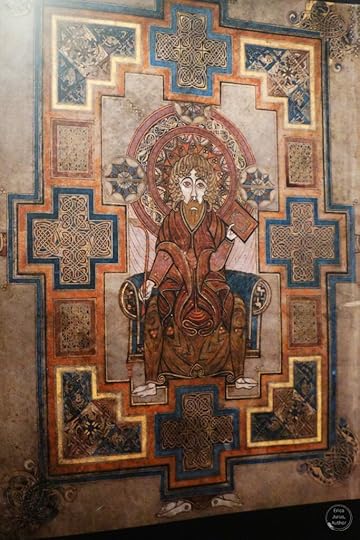 Section of the Book of Kells, from the gallery display at Trinity College, Dublin Ireland – by E. Jurus, Author, all rights reserved
Section of the Book of Kells, from the gallery display at Trinity College, Dublin Ireland – by E. Jurus, Author, all rights reservedIn my novels, Brother Domitian, who entered Penmon Priory in Wales at a young age, displayed a gift for illustration and became the main illustrator there before the Dissolution of the Monasteries in England by Henry VIII in 1536.
By the 14th century, a growing, educated middle class in Europe began requesting illuminated manuscripts for their private collections, particularly among the aristocracy. These books were often displayed in private libraries and then passed on as heirlooms.
Ironically, Henry VIII himself commissioned an illuminated Psalter, which contained Psalms and other devotional texts to be recited during the week for morning and evening prayers. He obtained it from a French illustrator, to show Henry performing in various capacities, from slaying Goliath to posing as a penitent (which was doubtful in real life). It can be seen in the British Library, including on their Digitised Manuscripts and Virtual Books websites.
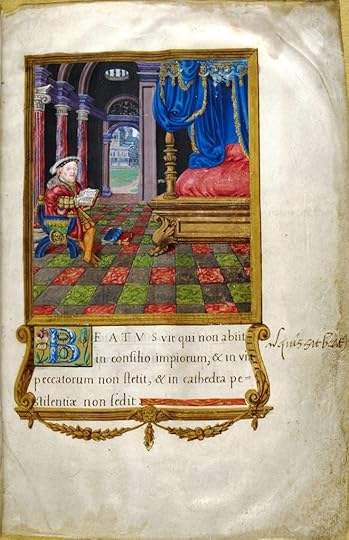 One of the folios (leaves) from Henry VIII’s Psalter, showing him reading – Source: British Library, By Medieval scribe and illuminator – British Library [1], Public Domain, https://commons.wikimedia.org/w/index.php?curid=17319921
One of the folios (leaves) from Henry VIII’s Psalter, showing him reading – Source: British Library, By Medieval scribe and illuminator – British Library [1], Public Domain, https://commons.wikimedia.org/w/index.php?curid=17319921Other types of illuminated manuscripts included the Antiphoner, a volume of music (hymns, prayers, etc.) used by all churches and monasteries for daily religious services; the Missal, used by a priest to conduce Mass and still in use to this day; the Breviary, containing hymns and readings for morning and evening prayer outside of Mass; and the Book of Hours, for personal use, so called because the cycle of prayer handed down from monastic life divided the day into eight segments or “hours” to conduct daily devotions in. The Book of Hours also included a calendar, listing major feast days of the church year.
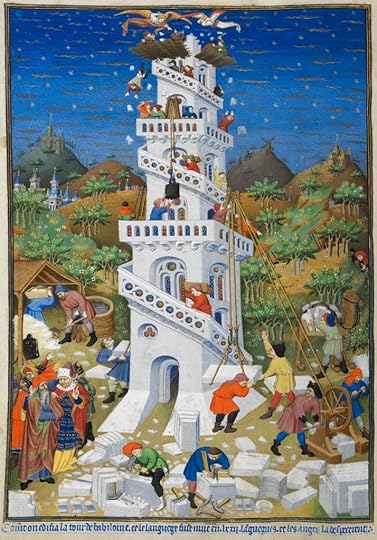 Bedford Hours; building the Tower of Babel, By Bedford Master – This file has been provided by the British Library from its digital collections. It is also made available on a British Library website. Catalogue entry: Add MS 18850, Public Domain, https://commons.wikimedia.org/w/index.php?curid=23030937
Bedford Hours; building the Tower of Babel, By Bedford Master – This file has been provided by the British Library from its digital collections. It is also made available on a British Library website. Catalogue entry: Add MS 18850, Public Domain, https://commons.wikimedia.org/w/index.php?curid=23030937Books of Hours were meant for anyone who could read, and became immensely popular because of their wonderful illuminations. They became status symbols, and families who’d never owned a book would pool their resources and by one. Books of Hours were the early best-sellers of the book world.
The field of Illuminated Manuscripts is too large for one blog post. Perhaps I’ll put together an entire document about it for special access one day. In the meantime, if you’re heading for a museum soon, do check out any mss (short-form plural for ‘manuscript’ for those ‘in the know’  ) they may have and enjoy their artistry in person.
) they may have and enjoy their artistry in person.
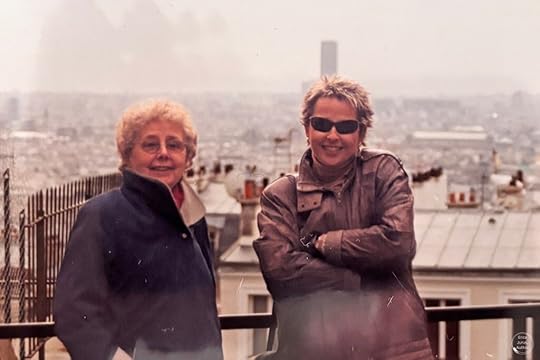 Mom-in-law Jenny and me (L,R in this pic) in Montmartre, overlooking the city of Paris; some damage (blurring) in the lower part of the photo – by Erica Jurus, Author, all rights reserved.
Mom-in-law Jenny and me (L,R in this pic) in Montmartre, overlooking the city of Paris; some damage (blurring) in the lower part of the photo – by Erica Jurus, Author, all rights reserved.
February 18, 2025
February 11, 2025
What’s Your Pleasure?
Hot, sweaty, panting? Sweetly suggested after The Kiss? One of the problems that always comes up for authors is how to portray sex in their novel.
Even if the book isn’t a ‘romance’ per se, there will be interactions between two human beings (or not so human – there’s an entire, um, genre that explores sex with aliens, or even monsters). Is it important to the story to give readers all the intimate details of a sexual encounter, or would it be gratuitous?
That was the question I had to ask myself when I was writing my novels. It would have been strange to write three sequential novels where no one had sex – that’s not the way life works. But did I need to open the doors to the bedroom, to portray all the nitty gritty?
I’ve read a lot of books in my main genre – urban fantasy – and they tend to lean one way or the opposite. Quite a few have had explicit sex scenes. Sometimes it was very well done, very erotic. Other times it was a bit of a letdown: big build-up of sexual tension between the characters, but when they finally got together it fell flat.
If a writer is going for eroticism, it’s not easy to get it right. Some writers have veered into outright smut, which I guess is what floated their boat. Still others have just kinda missed the mark. It really depends on the main storyline and what’s appropriate within it.
Sex in novels is loosely categorized as ‘open-door’, which follows the participants right into the bedroom (or other location) and invites the reader to live it with them, or ‘closed-door’, which stops more-or-less at the bedroom door, maybe offering a glimpse or two but not describing every heaving moment.
Explicit sex isn’t always intended to be enjoyable for the reader – it may have another purpose entirely, such as characters with ulterior motives, or even non-consent/violence – but when it is meant to be erotic, it’s all about the characters. It’s a fantasy played out on the page, or the screen. In the first season of Bridgerton on television there was a lot of sex going on, but viewers really zoomed in on the ‘fake romance’ storyline between the handsome, haughty Duke of Hastings and the lovely, feisty Daphne Bridgerton, who inevitably fell in love, got married and consummated their union quite passionately.
In an article in LitHub magazine featuring famous authors’ comments about how to write sex scenes, I think romance doyen Diana Gabaldon probably had the best take on how to write sex:
“First, a good sex scene is about the exchange of emotions, not body fluids. In other words, what’s going on physically is not really important. It’s what’s going on emotionally that’s important. You use the physical attributes or setting, only as a means of anchoring the reader in the moment, but it’s about what’s going on between these two people.
And that leads to the second principle, which is that a good sex scene can only happen between two unique and specific people. If you took one of say, Jamie and Claire’s sex scenes, and substituted the names Ana and Christian for theirs, it would not work. They are very specific, to each kind. And so, if you have a scene that could only be done by these two people, then it’s probably a good scene.” How to Write a Good Sex Scene, Literary Hub online magazine.
Often, less is more. Our imaginations are powerful tools in understanding what a writer or film director is getting at. Some of the sexiest scenes I’ve ever seen in movies are like visual foreplay, the suspense of will-they/won’t-they. The end result is clear, but the details are left up to our mind’s eye. In the 1966 romantic comedy Walk Don’t Run, set during the Tokyo Olympics when there’s a shortage of housing for visitors and athletes, suave older Cary Grant, a visiting businessman, talks a young woman, Christine (the pretty Samantha Eggar), into letting him crash in her apartment, then invites good-looking male athlete Steve (Jim Hutton) into the mix. Chaos and romance ensue during the forced proximity, but Christine is engaged to a stuffy British fellow. She fights her growing attraction to Steve, while Cary Grant’s character does his best at matchmaking and throwing the two younger people together. I won’t spoil the ending for you, but it satisfies the plot in a unique and charming way without going too far.
Harlequin, the grande dame of the romance genre, publishes several different subcategories, each with its own motif and submission guidelines. The Afterglow Books must include sexy romantic arcs with strong chemistry and explicit sex scenes that “bring the reader into the character’s thoughts, feelings, experiences and sensations using everyday language without euphemisms”. The Heartwarming collection, by contrast, needs to feature “Clean, sweet, feel-good stories that readers can share with friends and family of all ages”. (Source: Write for Harlequin)
Authors need to write what’s authentic for their story. I chose to write “closed-door sex”. What’s important about my heroine’s journey is her fight to understand the supernatural world she’s been dragged into and all the clandestine things going on in the world. Penning the details of her bed romps wouldn’t have added anything significant to my readers’ understanding of her character or motivations.
There’s something out there for everybody’s tastes. Readers will choose what they like, and it’s our jobs as writers to satisfy them.
February 4, 2025
Storytelling: Winter Escapism and the Inspiration for Indiana Jones
Inspiration comes in all forms. Sometimes it’s a post to Instagram celebrating International Pisco Sour Day 
My dad and I loved to watch adventure movies together. While Journey to the Centre of the Earth has always been my favourite from our virtual Sunday escapades, another movie that really stuck in my head, though it’s become obscure now, was 1954’s Secret of the Incas. To my young mind, it held so much mystery, with its on-location filming in Cuzco and on Machu Picchu, and so much swash. And the most memorable part, I guess because it seemed so sophisticated and exotic: the Pisco Sour, imbibed by the hardened adventurer Harry Steele and all the travellers to Cuzco in a low-key bar full of atmosphere.
It’s amazing what resonates with you. I grew up really wanting to visit to Peru, and above all to have that cocktail.
 Shot of the movie title screen on our television – by E. Jurus, all rights reserved
Shot of the movie title screen on our television – by E. Jurus, all rights reservedAdventure movies in the middle of winter, when it’s too cold to leave the house, are a great form of escapism. We watch the heroes/heroines romp through mountains and temples and raging rivers, finding golden statues and dodging cunning traps.
I love the films made in the earlier days of Hollywood – pure pleasure to watch, not to be taken too seriously, just a jungle Jeep or Pan-Am Clipper full of fun. I think would have loved to travel in those days, when the journey itself was a great part of the adventure, but I have to make do with watching the movies.
So for your viewing pleasure, I offer up a movie that heavily inspired the look of a much later intrepid hero named Indiana Jones. As soon as you see Harry Steele, played by Charlton Heston, walk around with his fedora and leather jacket, you’ll know I mean.
The costume designer for Raiders of the Lost Ark, Deborah Nadoolman Landis, confirmed that the crew watched Secret of the Incas several times and definitely drew inspiration. She even said that the film was “almost a shot for shot Raiders of the Lost Ark”.
Harry Steele isn’t an archaeologist, however. He’s self-serving and not overly scrupulous tourist guide around Cuzco, the one-time capital of the Inca empire, cradled by the Andes Mountains and steeped in sacred sites. The motivation behind everything he does is to find a fabled treasure, a golden, jewelled Inca “sunburst”, rumoured to be somewhere in the ancient citadel of Machu Picchu. His direct competition is bar owner Ed Morgan, who’s been searching for the sunburst himself for fourteen years. Now Ed’s older, grizzled and increasingly desperate to fulfill his longtime wish before he dies.
Harry’s advantage is that he has a piece of an artifact that fits into a carved stone model of Machu Picchu in a Cuzco museum, showing the location of the sunburst. All he needs is the means to get up there, which he unexpectedly stumbles across when he decides to help a beautiful woman named Elena Antonescu, a Romanian defector who’s travelling illegally and is being pursued by an official with a small airplane. In her own desperation, she agrees to help Harry steal the plane, thinking that he’s taking her to Mexico
Diverting to Machu Picchu, he and Elena find an archaeological expedition preparing to enter the tomb where the sunburst is supposedly concealed. Harry invents a reason to stay, Ed Morgan tracks them down, the archaeologist falls for Elena, and the fun continues as each player pursues their own desires. I won’t spill the rest.
 Machu Picchu in modern times. What you see in all the photos is only a small portion of the entire citadel. – by E Jurus, all rights reserved
Machu Picchu in modern times. What you see in all the photos is only a small portion of the entire citadel. – by E Jurus, all rights reservedThe movie was filmed on location, and when I watch it now and I can readily recognize the same parts of Cuzco that my hubby and I walked around. It was one of our favourite places in Peru, cradled in the Sacred Valley high in the Andes (at about 11,000 feet, it takes some acclimation). It’s fun to see it as it was seventy-odd years ago, with prop planes flying in and landing on dirt airstrips, and a rudimentary railroad switch-backing across the main road.
 Walking the streets of the central plaza in Cuzco – by E Jurus, all rights reserved
Walking the streets of the central plaza in Cuzco – by E Jurus, all rights reserved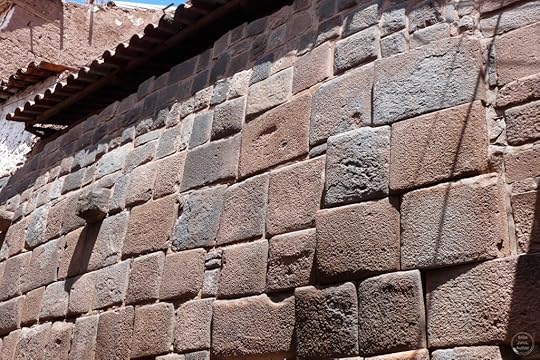 One of the original Incan walls in Cuzco, still standing after so many Spanish additions have crumbled during successive earthquakes – by E Jurus, all rights reserved
One of the original Incan walls in Cuzco, still standing after so many Spanish additions have crumbled during successive earthquakes – by E Jurus, all rights reserved Courtyard of the Inca Museum in Cuzco – by E Jurus, all rights reserved
Courtyard of the Inca Museum in Cuzco – by E Jurus, all rights reservedAnd we get to see Machu Picchu in a more raw state, not as pristinely excavated as it is now and full of mystery.
To get to the ancient site, Harry and Elena abandon the plane, raft down the Urubamba River, and hike four thousand feet up the mountain, which Elena remarkably accomplishes in a skirt and pumps with heels. Ahh, Hollywood. Nevertheless, the scenery is as spectacular as when we were there and will give you a real sense of the enigmatic city in the clouds.
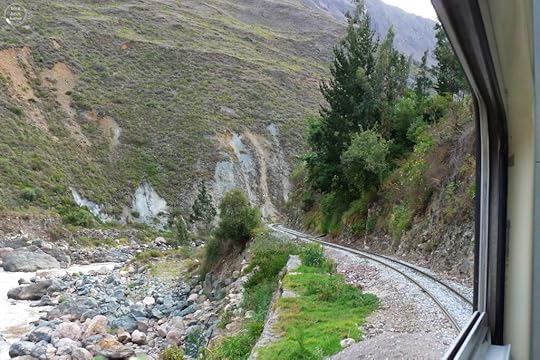 Nowadays, a train runs from Ollantaytambo to Aguas Calientes, the closest town to the Machu Picchu site, following the winding Urubamba River – by E. Jurus, all rights reserved
Nowadays, a train runs from Ollantaytambo to Aguas Calientes, the closest town to the Machu Picchu site, following the winding Urubamba River – by E. Jurus, all rights reserved From Aguas Calientes, you can get up the Machu PIcchu mountain in more comfort, even if the narrow hairpin turns make it feel more death-defying – by E. Jurus, all rights reserved
From Aguas Calientes, you can get up the Machu PIcchu mountain in more comfort, even if the narrow hairpin turns make it feel more death-defying – by E. Jurus, all rights reserved The Incas were brilliant at water management, and one of these reservoirs was apparently used as a bath in the movie – by E. Jurus, all rights reserved
The Incas were brilliant at water management, and one of these reservoirs was apparently used as a bath in the movie – by E. Jurus, all rights reservedFive hundred indigenous people were used as extras in the movie, and plenty of local llamas as well  . Peruvian-born singer Yma Sumac, herself of Indian-Spanish descent, inspired writer Sidney Boehm with the idea for the movie after he met her at a party. She was very popular in Hollywood at the time, with her exoticism and powerful voice, and made her screen debut in the film.
. Peruvian-born singer Yma Sumac, herself of Indian-Spanish descent, inspired writer Sidney Boehm with the idea for the movie after he met her at a party. She was very popular in Hollywood at the time, with her exoticism and powerful voice, and made her screen debut in the film.
You can watch the entire movie on Youtube, or purchase it on Amazon Prime. If you can find some Pisco brandy at the liquor store, you can fix yourself some Piscos, put on your old fedora, put up your feet and escape into a wild adventure in Peru for a couple of hours.
 Pisco Sour – by E. Jurus, all rights reserved
Pisco Sour – by E. Jurus, all rights reserved
January 28, 2025
On hiatus this week
I’m on hiatus this week to finish the final book of my Chaos Roads trilogy. See you in February 
January 21, 2025
On hiatus this week and next
I’m on hiatus this week and next to finish the final book of my Chaos Roads trilogy. See you in February 
January 14, 2025
Rosemary: cook, remember and ward off the Plague
One of the things I love the most about December is its fragrances, of fresh evergreens in the house, bay or pine scented candles, good food on the stove and in the oven – and on the table.
One of the things I love the least about winter as it moves on into January and February is its lack of aromas. The ice and snow have coated everything in a chilly seal that keeps scents hidden away.
So winter has always been a time, for me, of drawing aromas back out again, sometimes with fresh flower arrangements, but most often through cooking.
The herb Rosemary is perfect for winter stews, with a woodsy, almost briny flavour from its origins along the Mediterranean coast. Its original scientific name, Rosmarinus officinalis, refers to the drops of sea spray on its leaves from the salty waters surrounding it.
Because the plant was evergreen, rosemary became a symbol of immortality. The ancient Egyptians, after using it while embalming their dead, also added sprigs of it to the burial rites in order to protect their souls on the journey to the afterlife, while the ancient Greeks and Romans often carried sprigs of rosemary in funeral processions and placed them on the deceased at the burial site. It’s still used in funerals to this day, and in 2022 was part of the floral arrangement on Queen Elizabeth II’s casket.
 Queen Elizabeth II’s casket in the funeral procession, by Department for Digital, Culture, Media and Sport – https://www.flickr.com/photos/49429730@N08/52371195916/, Public Domain, https://commons.wikimedia.org/w/index.php?curid=123188653
Queen Elizabeth II’s casket in the funeral procession, by Department for Digital, Culture, Media and Sport – https://www.flickr.com/photos/49429730@N08/52371195916/, Public Domain, https://commons.wikimedia.org/w/index.php?curid=123188653It was also renowned for strengthening the memory. Ancient Greek scholars would twine the herb in their hair when studying for exams, and then rosemary crowns during the exams to help them remember what they’d been taught. (Wish I’d known that during university.) Recent scientific studies have shown that eating or breathing the aroma of rosemary does enhance cognitive functions.
Rosemary’s medicinal properties weren’t lost on ancient cultures – it was used for a variety of ailments: fatigue, pain, indigestion, inflammation, even jaundice. Hippocrates, the ancient Greek physician known as the “Father of Medicine”, would treat joint pain with an ointment made of the plant’s flowers and leaves macerated in olive oil.
In Medieval times, rosemary was believed to offer protection from the plague. In the 14th century, the Black Death took out up to 60% of the entire population of Europe, and also swept through Asia and Africa. The total death count was an estimated 50 million people. It was a terrifying spectacle each time there was an outbreak, thought to be the Hand of God.
As a result, during an outbreak in 1603, when 38,000 Londoners died in very short order, the demand for the herb was so high that the price for an armful of branches increased from one shilling, which would buy an entire pig or 18 gallons of good ale, to six shillings for a handful.
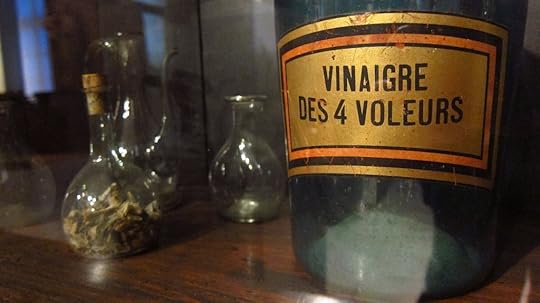 A vintage bottle of Four Thieves Vinegar – by Olybrius – Self-photographed, CC BY-SA 3.0, https://commons.wikimedia.org/w/index.php?curid=16409086
A vintage bottle of Four Thieves Vinegar – by Olybrius – Self-photographed, CC BY-SA 3.0, https://commons.wikimedia.org/w/index.php?curid=16409086There was even a concoction called “Four thieves vinegar”, made from wine or cider vinegar and steeped with herbs like rosemary, along with spices and garlic. Legend had it, during a plague outbreak, a group of thieves was caught robbing the sick and dead. In exchange for leniency, they offered to exchange their secret medicinal recipe, which had allowed them to commit the robberies without catching the disease.
A recipe in the Museum of Paris in 1937, said to have been an original copy of the recipe posted on the walls of the city of Marseille during one of the outbreaks, instructed:
Take three pints of strong white wine vinegar, add a handful of each of wormwood, meadowsweet, wild marjoram and sage, fifty cloves, two ounces of campanula roots, two ounces of angelica, rosemary and horehound and three large measures of camphor. Place the mixture in a container for fifteen days, strain and express then bottle. Use by rubbing it on the hands, ears and temples from time to time when approaching a plague victim.
Rosemary’s powers were extended to the supernatural as well – it was believed to keep evil spirits at bay. In Spain, it was used to protect against witchcraft and other menaces on the road. (Spanish roads of the time sound a great deal like the Roads in my Chaos Roads Trilogy.)
Covering the ground with fragrant herbs was a common practice in the Middle Ages, to mask any off-putting odours from the compacted-earth floors and laughable sanitation systems of the time. Malodours were thought to bring disease, which wasn’t that far off the mark considering that those vapours arose from cesspools, while nature’s aromas were considered revitalizing and healing.
Smelling rosemary on Christmas Eve was believed to bring a year of health, happiness and good luck, and it became a tradition to scatter the herb on the floor that night and tread upon its leaves to release the fresh aroma, which must have been quite a pleasant change from the usual odours.
Drawing on all of these legends, rosemary became a staple in classic literature. In Shakespeare’s play Hamlet, Ophelia, losing her sanity after the tragic death of her father, Polonius, distributed imaginary flowers to everyone she met, saying “There’s rosemary, that’s for remembrance. / Pray you, love, remember.”
When Miguel de Cervantes wrote Don Quixote, he tasked the titular knight with making and consuming the Balsam of Fierabras, a miraculous substance that would heal whoever drank it. Don Quixote ended up vomiting and sweating, but healed after sleeping. For his trusty aide Sancho Panza, it had so much of a laxative effect that he almost died. To prepare the potion, Quixote used what’s called an ensalmo, a combination of potion and prayer with various gestures and signs to cure the sick. Such a ritual was forbidden by the Church.
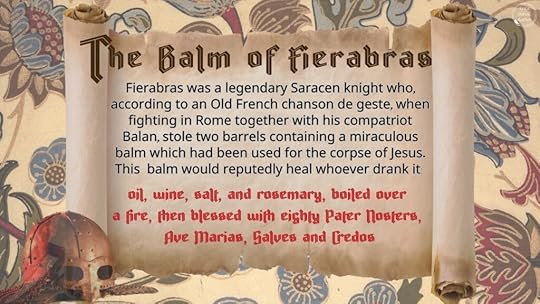
Rosemary wood was even prized for making musical instruments, and it was said that using a comb made with the wood for one’s hair would prevent ‘giddiness’ (perhaps lightheadness, which must have happened often to have special hair implements created!).
So the next time you make a delicious, cozy meal with rosemary, you’re not just cooking with a pleasant herb, you’re truly cooking with history.
Here’s a recipe with rosemary from BBC Good Food that sounds delightfully sunshiny on a dreary winter day, Rosemary Chicken with Oven-roasted Ratatouille. I haven’t tried it out yet, but I plan to this week!
January 7, 2025
A year in images that speak
Writers notice a lot, and sometimes that manifests in photographs instead of words I know several writers who are also photographers, using another medium to convey ideas that have fascinated us, enchanted us, haunted us. We record images that inspire, remind us of something we want to use in our books, or enrich our time away from the keyboard. So here are a few of my favourite such photographs from the past year. They each capture a little moment in time, just as my stories do. I hope you like them.
 Photo by E. Jurus, all rights reserved.
Photo by E. Jurus, all rights reserved.Signs of spring finally emerging in our local gardens. It felt like a long winter, and I wasn’t able to leave the house much, so a walk in the fresh air with bursts of colour and new growth felt indescribably reviving.
 Photo by E. Jurus, all rights reserved.
Photo by E. Jurus, all rights reserved.Heartland Forest is worth a journey when it becomes a froth of spring green, as if Mother Nature has strewn verdant lacework everywhere. You have to catch it quickly, before the leaves grow larger and darker, just at this perfect moment that feels like you’ve crossed over into some kind of enchanted realm.
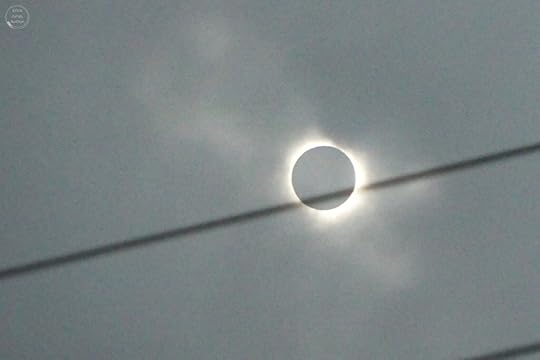 Photo by E. Jurus, all rights reserved.
Photo by E. Jurus, all rights reserved.The incredible hoopla around the rare solar eclipse in early April almost turned into a complete bust, even though we live right in the path of its totality. I ordered special viewing glasses months ahead of time so that we could watch the event safely. In Niagara Falls, the excitement was incredible, along with soaring hotel prices and bad hotel practices. But my hubby and I didn’t need to worry about that; all we had to do was step out into our backyard — or so we thought. As the totality approached, the sky was filled with clouds, and we thought, You have to be kidding us! Finally, with the event just minutes away, we decided to hop in our truck and try to find any patch of sky in the vicinity, and suddenly, as we were driving along the Welland Canal, there it was, just for a few moments during brief breaks in the cloud cover. Day turned into night, just as it was supposed to, and I even managed to take several decent photos — not great, but far better than we’d hoped for. We saw the Diamond Ring phenomenon, then returned home to enjoy the special meal I’d concocted, grateful that we hadn’t been cheated out of this once-in-a-lifetime event.
 Photo by E. Jurus, all rights reserved.
Photo by E. Jurus, all rights reserved.I took a friend to the Royal Botanic Garden in Hamilton for cherry blossom time. On a beautiful spring afternoon with a deep blue sky, the trees presented their dance of white blossoms filled with tiny bees creating a soft hum. We strolled for a while, then had a picnic. Magical day.
 Photo by E. Jurus, all rights reserved.
Photo by E. Jurus, all rights reserved.Despite all the advantages of modern technology, which has seen me through several jobs and allowed me to publish my novels and sell them online, there’s something special about the days when people went outside to enjoy fine weather and gentle amusements. Luckily, those days aren’t completely lost. Midway State Park in Bemus Point, New York, is a vestige of old-time America that’s a complete delight to visit. Rides are all low-tech, low cost and child-friendly. They’re scattered around a large property along Chautauqua Lake, and there are picnic tables to enjoy some refreshments, whether you buy some on site or bring your own. Tilt-o-Whirl rides like this one have been around for decades, and still bring pleasure to young and older alike, in the good old summertime.
 Photo by E. Jurus, all rights reserved.
Photo by E. Jurus, all rights reserved.If you think this is an innocent summertime beverage, you’re quite wrong. This is a Chocolate-Peanut Butter Adult Milkshake that we had in Bemus Point as ‘dessert’ after a fine lunch at a restaurant overlooking the lake, with “Adult” meaning “spiked”. There have to be some advantages to being grown up, after all 
 Photo by E. Jurus, all rights reserved.
Photo by E. Jurus, all rights reserved.Fortunate to live in an agricultural area, I love to explore the farm stands in early summer just to bring home some glistening ripe bounty. Look at those strawberries, just waiting to be turned into a fabulous dessert. While I don’t love the summer season around here (too humid), I do love this aspect of it.
 Photo by E. Jurus, all rights reserved.
Photo by E. Jurus, all rights reserved.No bees, no summer bounty. I have a friend who’s really into bees, and she’s infected me with it as well. I follow bees around for hours trying to get good photos of the flighty little charmers, and was really tickled when this one turned out. Bees truly are amazing creatures, and I enjoy learning all about them via my bee-buddy. Here’s to you, Charmaine!
 Photo by E. Jurus, all rights reserved.
Photo by E. Jurus, all rights reserved.This photo reminds me of the old Beauty and the Beast story. I’m not sure why exactly — something about the moody, gothic look to it, with the lush crimson flowers strewn amongst tall trees and topiary. I think it has a fairy-tale quality — do you?
 Photo by E. Jurus, all rights reserved.
Photo by E. Jurus, all rights reserved.We had the most amazing visit to the old Herschell Carousel Factory in West Tonawanda, New York. I’ve always loved carousels, and being able to visit a place where they’ve been made was awesome. One of the best parts was seeing how the rolls of organ music were produced — here you can see the rolls of paper that have been marked according to a piece of music and punched with little metal punches so that each instrumental part of the player organ replicates the tune correctly. Then we watched a roll play out on an actual vintage organ — three closely-spaced punches created a staccato flurry with little drumsticks on a snare drum, several more played the horn section… So fascinating to watch!
 Photo by E. Jurus, all rights reserved.
Photo by E. Jurus, all rights reserved.There’s little better than a hike through the woods, surrounded by its aromas and green space — here at Panama Rocks in New York State, where the paths wander through a remarkable geological formation of rock canyons. Not the easiest hike, with some scrambling up and down the slopes involved, but well worth the effort.
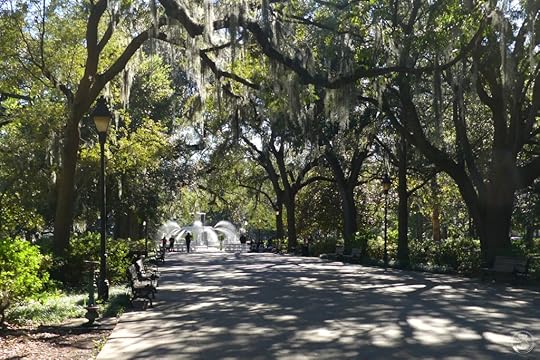 Photo by E. Jurus, all rights reserved.
Photo by E. Jurus, all rights reserved.In the fall we embarked on a long road trip down to Florida to visit friends, stopping at a few places along the way. One of them was Savannah, Georgia, a beautifully gracious old Southern city. Lots of history interspersed with shady parks that drip with Spanish moss and atmosphere. We had lunch in an old warehouse dating back to the 1800s as we watched river traffic pass by. I highly recommend a visit.
 Photo by E. Jurus, all rights reserved.
Photo by E. Jurus, all rights reserved.These gorgeous (to me) iguanas are something of a nuisance in Florida, but they’re so striking, and huge! Everything we see in nature is a gift not to be taken for granted.
 Photo by E. Jurus, all rights reserved.
Photo by E. Jurus, all rights reserved.We had a celebration of three milestone wedding anniversaries at a famous restaurant in Miami, Joe’s Stone Crab. Pat Sajak and Vanna White even made a point of going there on a location shoot of Wheel of Fortune. We had great fun wearing the enormous paper bibs the staff gives you so that you can cheerfully tear into the food without worrying about your clothing. A truly memorable meal.
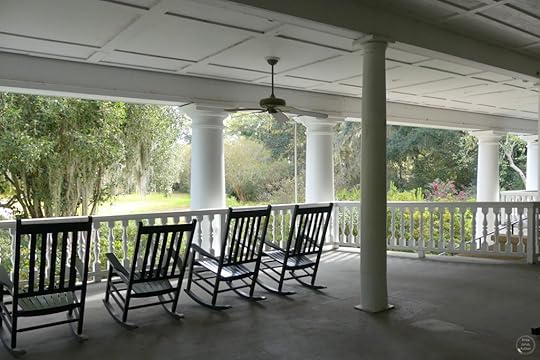 Photo by E. Jurus, all rights reserved.
Photo by E. Jurus, all rights reserved.We visited an old plantation outside of Charleston, South Carolina, on our meandering path back to home, and the house’s wide, shaded verandah was the epitome of Southern style. The house itself was spacious but understated — I could live there, sipping iced tea on a warm day. I read Gone With the Wind when I was nine years old, and remember going to see the movie at the theatre with my mom before the days of being able to rent it any time we wanted. Having learned a lot since then, I can now recognize the influence that author Margaret Mitchell’s upbringing in a slave-holding household had on her portrayals of Mammy and the other slaves at Tara plantation in the novel, but with that in mind, it was still enjoyable to see a piece of vividly-drawn history brought to life.
 Photo by E. Jurus, all rights reserved.
Photo by E. Jurus, all rights reserved.In November I was delighted to participate in the St Catharines Public Library’s first annual LitFest celebration of literature and reading. This was the library I grew up with and spent a great deal of time at when I was younger, and it’s such an honour now to have my books on their shelves for anyone to borrow and read. I made some sales, but more importantly, I got to chat with people who love reading as much as I do, as well as to meet with other adult authors in the area and talk some shop. Truly a pleasure all around.
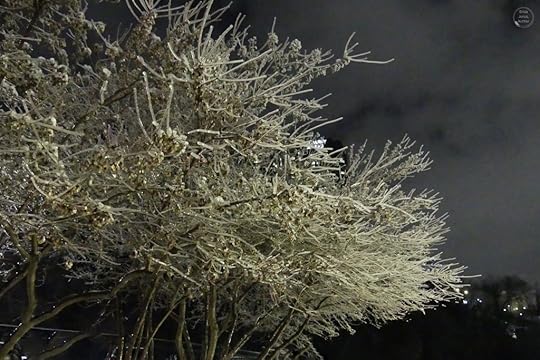 Photo by E. Jurus, all rights reserved.
Photo by E. Jurus, all rights reserved.Winter made an icy entrance much sooner than any of us anticipated here in Ontario. On a night when hubby and I bundled up and strolled the Winter Festival of Lights in Niagara Falls, I took this photo of a ghostly, ice-encrusted tree along the path. Some of the best horror stories are set in the winter, I feel, when the cold is isolating and lends an eerie otherness. Krampus is one of my favourite Christmas movies, not only because it subverts the sugar-sweet raft of Christmas romances, but for its adroit use of a snow storm to strand the family and turn the landscape into a monster’s hunting ground. But plenty of people were out enjoying the beautiful light displays along the Falls, no Krampus in sight 
 Photo by E. Jurus, all rights reserved.
Photo by E. Jurus, all rights reserved.And on the last night of the old year we spent time at the spectacular silk lantern festival at the Nashville Zoo, where we were in the vicinity visiting a cousin. Each vignette, such as the one you see in this photo, tells its own story, and for this purpose, a picture really is worth a thousand words. A low-key, lovely way to close out the year.



